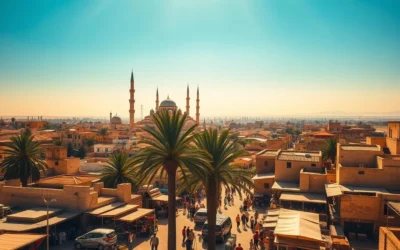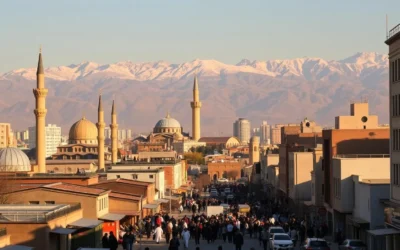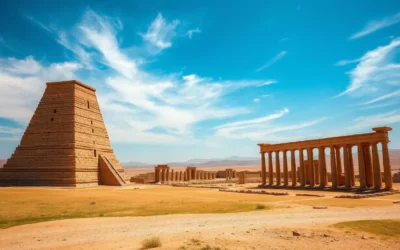✓ Accommodations✓ Flights✓ Rental Cars
Step into a place where history comes alive. Ur, a key city in ancient Mesopotamia, offers a glimpse into the rise of the Sumerian civilization. Founded around 3800 BCE, this remarkable location is a treasure trove of archaeological wonders.
One of the most iconic sites is the Great Ziggurat of Ur, standing at 30 meters tall with three levels. Built around 2100 BCE, it showcases the advanced engineering and religious significance of the time.
This trip is perfect for those fascinated by ancient history. Explore royal tombs, intricate artifacts, and sophisticated urban planning that reveal the ingenuity of its people.
Ur’s blend of historical importance and cultural richness makes it a must-visit destination. Prepare to immerse yourself in a journey through time, uncovering the secrets of this ancient city.
Discovering Ur’s Ancient Legacy
Dive into the heart of ancient Mesopotamia and its cultural legacy. This remarkable city was a cradle of early civilization, shaping the way societies developed over time. From its innovative urban planning to its thriving trade networks, Ur played a pivotal role in the rise of the Sumerian civilization.
Rise of the Sumerian Civilization
Ur’s deep historical roots trace back to the sixth millennium BCE, marking the transition from hunting and gathering to settled farming practices. The city’s strategic location in southern Mesopotamia allowed it to flourish, becoming a hub for trade and cultural exchange. Over time, Ur evolved into a sophisticated urban center, showcasing the ingenuity of its people.
Key Archaeological Discoveries
One of the most significant finds is the Standard of Ur, a stunning artifact that depicts everyday life and warfare in ancient Sumer. This piece offers a glimpse into the way people lived, worked, and interacted during that time. Other discoveries include intricate artifacts and royal tombs, each revealing a piece of Ur’s rich history.
| Discovery | Significance |
|---|---|
| Standard of Ur | Depicts daily life and warfare |
| Royal Tombs | Showcases urban planning and burial practices |
| Great Ziggurat | Symbolizes religious and architectural achievements |
Each day spent exploring Ur feels like a journey through centuries. The city’s ancient legacies continue to influence our understanding of history, offering valuable insights into the development of human civilization.
Exploring the Great Ziggurat of Ur
Discover the towering marvel of the Great Ziggurat, a testament to ancient engineering. Built around 2100 BCE, this iconic structure stands as a symbol of Sumerian ingenuity and religious devotion. Its step pyramid design, with three levels, showcases the advanced construction techniques of the time.
Structure and Design
The Great Ziggurat’s base measures 64 meters by 46 meters, with an original height estimated at 20 meters. Constructed using mud bricks with a reed core and covered with kiln-fired bricks, it exemplifies Mesopotamian architectural style. The structure’s multiple levels were designed to elevate it closer to the heavens, reflecting its sacred purpose.
Religious Significance
This ancient temple was dedicated to Nanna, the moon god, serving as a central religious site for the Sumerians. It functioned as a bridge between the mortal and divine realms, emphasizing the spiritual connection of the people to their deities. The Ziggurat’s design and location were carefully chosen to align with religious beliefs and practices.
Significant restoration efforts during the 1980s have preserved this historic site, making it accessible to visitors today. Located near Nasiriyah, it’s a short drive from the city, offering a glimpse into the rich history of the region. Plan your visit between October and March for the best experience.
Exploring the Great Ziggurat is a journey through time, offering insights into the history and culture of ancient Mesopotamia. Whether you’re a travel enthusiast or a history buff, this site is a must-see destination.
Unveiling Royal Tombs and Archaeological Sites
Uncover the secrets of ancient royalty through the treasures of Ur. The royal tombs, discovered during excavations, reveal the opulence of Sumerian kings. These sites offer a fascinating glimpse into the lives of the elite, showcasing their wealth and cultural practices.
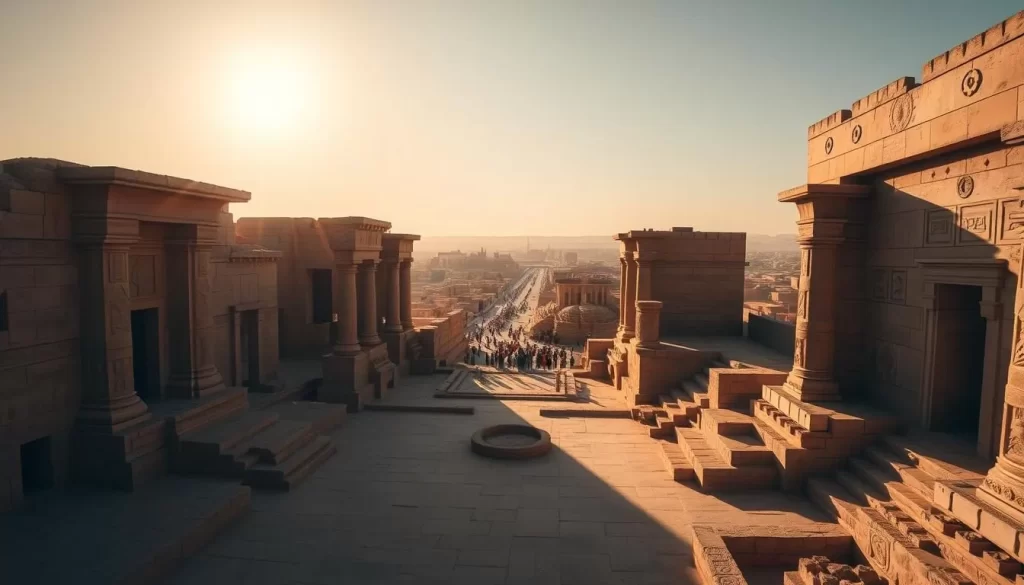
Among the most remarkable finds is the Standard of Ur. This intricate artifact depicts scenes of daily life and warfare, providing insight into the world of ancient Sumer. Its craftsmanship and symbolism highlight the sophistication of their society.
Another must-see is the Queen’s Lyre, a stunning musical instrument adorned with gold and lapis lazuli. This piece not only reflects artistic excellence but also connects us to the rituals and traditions of the past.
“These artifacts are more than just objects; they are windows into the lives of those who shaped history.”
Exploring these sites on a tour allows you to appreciate their significance. Each discovery offers a tangible link to ancient rituals, trade, and cultural exchange. It’s a thing that enriches your understanding of this remarkable civilization.
Whether you’re a history enthusiast or a curious traveler, the royal tombs and artifacts of Ur are a must-see. They provide a unique perspective on the world of ancient Mesopotamia, making your journey truly unforgettable.
Experiencing Daily Life in Ancient Residential Areas
Walk through the ancient streets of a city that thrived thousands of years ago. The residential areas of this ancient city reveal a world of innovation and community. Here, you’ll discover how people lived, worked, and interacted in a bustling urban center.
Urban Planning and Architectural Features
The layout of the streets and homes showcases the ingenuity of Sumerian builders. Wide, well-organized pathways connected neighborhoods, while efficient drainage systems kept the city functional. Mud-brick construction was a hallmark of these structures, ensuring durability over the years.
Homes were designed with practicality in mind. Thick walls provided insulation, and courtyards offered spaces for family gatherings. These architectural features highlight the advanced thinking of the ancient city’s residents.
Daily life here was vibrant. Markets buzzed with trade, and community spaces fostered social interaction. The design of the streets and homes continues to influence modern urban planning.
Exploring these areas gives you a glimpse into a civilization that shaped history. From the layout of the streets to the construction of homes, every detail tells a story of innovation and resilience.
Ur, Iraq: Best Things to Do – Top Picks: Must-See Attractions
Immerse yourself in the timeless allure of ancient wonders. This curated list of must-see attractions blends history and adventure, offering an unforgettable experience for every visitor. From iconic landmarks to hidden gems, these sites are perfect for history enthusiasts and culture buffs alike.
Start your journey at the Great Ziggurat, a towering marvel of ancient engineering. This structure, built around 2100 BCE, stands as a testament to Sumerian ingenuity and religious devotion. Its step pyramid design and sacred purpose make it a highlight of any trip.
Next, explore the royal tombs, where treasures from the past await. These sites reveal the opulence of Sumerian kings and offer a glimpse into their lives. The Standard of Ur and the Queen’s Lyre are among the most remarkable artifacts on display.
Don’t miss the museum exhibits, which feature a vast collection of Sumerian artifacts. These displays provide deeper insights into the culture and daily life of this ancient civilization. Each piece tells a story, enriching your understanding of the past.
For a unique experience, venture off the beaten path to lesser-known spots. These hidden gems add depth to your journey, revealing aspects of history often overlooked. Whether it’s a quiet corner of the city or an unmarked archaeological site, these discoveries are worth the effort.
| Attraction | Highlights |
|---|---|
| Great Ziggurat | Architectural marvel, religious significance |
| Royal Tombs | Opulent artifacts, royal history |
| Museum Exhibits | Collection of Sumerian artifacts |
| Hidden Gems | Lesser-known sites, unique discoveries |
To make the most of your visit, plan your trip between October and March for pleasant weather. Purchase entrance tickets in advance, especially for the Ziggurat, to avoid delays. Whether you’re a first-time visitor or a seasoned traveler, these attractions promise an enriching experience.
Plan Your Visit: Best Time and Accessibility
Embark on a journey to explore one of the world’s oldest civilizations. Timing your trip is crucial for a comfortable and enjoyable experience. The best months to visit are from November to March, when temperatures range from 15-25°C (59-77°F), making it ideal for sightseeing.
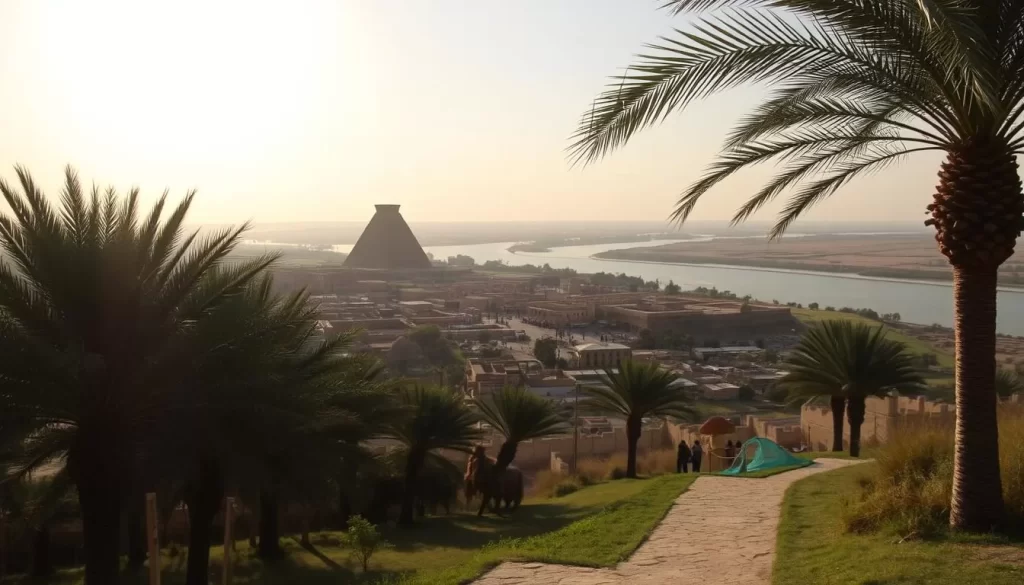
Ideal Seasons for Visiting
Summer months, from April to October, can be extremely hot, with temperatures soaring between 30-50°C (86-122°F). This makes outdoor activities challenging and less enjoyable. Plan your visit during the cooler months to fully appreciate the historical sites without discomfort.
Transportation Options and Access Tips
Getting to this ancient site requires careful planning. Limited public transportation options are available, so hiring a private car or joining a guided tour is recommended. Be prepared for security checkpoints along the way, which may involve document verification and short waits.
- Private Car Hire: Offers flexibility and convenience, especially for navigating checkpoints.
- Shared Taxis: A budget-friendly option, though less predictable in terms of timing.
- Guided Tours: Provide expert insights and handle logistics, ensuring a smooth experience.
Traveling during the recommended months and choosing the right transportation method will enhance your visit. With proper planning, you can focus on immersing yourself in the rich history and culture of this remarkable destination.
Safety Tips and Cultural Considerations
Understanding local customs and staying safe are key to enjoying your journey. Respecting cultural norms and being prepared for security measures will ensure a smooth and respectful experience.
Local Customs and Attire
Dressing modestly is essential when visiting this area. Opt for clothing that covers shoulders and knees, especially when exploring religious sites. This shows respect for local traditions and helps you blend in.
Greetings are important in local culture. A simple “a salaam alaikum” (peace be upon you) with a response of “Wa Alaikum Salaam” (and peace be upon you) can go a long way in building rapport.
Security Measures and Checkpoints
Security is a priority in this area. Be prepared for occasional checkpoints, especially when traveling between cities. Carry identification and remain patient during inspections.
Choosing the right hotel can enhance your safety. Opt for accommodations in well-secured areas, and avoid traveling alone at night. This minimizes risks and ensures a comfortable stay.
By following these tips, you can navigate the lot of cultural and security considerations with ease. This allows you to focus on the rich history and unforgettable experiences this destination offers.
Exploring Local Markets and Traditional Cuisine
Step into the vibrant world of local markets and traditional flavors. These bustling hubs are where you’ll experience the true essence of the region. From colorful stalls to the aroma of freshly prepared dishes, every corner tells a story.
Traditional Iraqi cuisine is a highlight of any visit. Dishes like masgouf, a grilled carp fish, and dolma, stuffed vegetables, have been enjoyed for centuries. These recipes are a testament to the rich culinary heritage of the area.
Local markets are a treasure trove of unique finds. Handmade carpets, copper works, and embroidered textiles are just a few of the items you can discover. Prices range from $2 for spices to $500 for intricate carpets, offering something for every budget.
Navigating these markets is an adventure. Friendly vendors often share stories about their crafts, adding a personal touch to your purchases. It’s a great way to connect with the culture and bring home meaningful souvenirs.
Here are some must-try experiences:
- Street Food: Sample kebabs and flatbreads from local vendors.
- Artisan Crafts: Visit stalls selling pottery and textiles.
- Spice Markets: Explore the vibrant colors and aromas of local herbs.
Exploring these markets and savoring traditional dishes is more than just a thing to do—it’s a journey into the heart of the region. Whether you’re a foodie or a culture enthusiast, this experience will leave a lasting impression.
Accommodations and Travel Logistics in Ur
Planning your stay near this ancient site is easier than you might think. While Ur itself has limited onsite accommodations, nearby Nasiriyah offers a variety of hotels and guesthouses to suit different budgets and preferences.
Nearby Hotels and Guesthouses
For a comfortable stay, consider options like the Ziggurat Hotel and Ur Hotel, both favorites among past travelers. These accommodations provide modern amenities while keeping you close to the historical ruins.
Travel logistics are streamlined to enhance your experience. Booking a room in advance ensures availability, especially during peak seasons. Many hotels also offer local transport arrangements, making it easy to explore the area.
Here are some top recommendations:
- Ziggurat Hotel: Known for its proximity to the site and excellent service.
- Ur Hotel: Offers a blend of comfort and convenience, perfect for history enthusiasts.
- Local Guesthouses: Budget-friendly options with a homely atmosphere.
For more detailed insights, check out this travel guide on Ur, Iraq. It provides valuable tips on navigating the region and making the most of your visit.
By choosing the right accommodation and planning your transport, you can enjoy a hassle-free stay near this remarkable local destination.
Day Trips and Nearby Attractions from Ur
Expand your adventure beyond the ancient ruins with nearby attractions. These destinations offer a mix of natural beauty, cultural richness, and historical significance, making them perfect for day trips. Whether you’re a tourist seeking stunning photo opportunities or a history enthusiast eager to explore more, these spots will enrich your journey.
Exploring Nasiriyah
Nasiriyah, located just a short drive away, is a vibrant city with deep historical roots. It’s home to the Mesopotamian Marshes, a UNESCO World Heritage Site known for its diverse wildlife and lush landscapes. Here, you can book a small boat for $20-$25 and glide through the waterways, capturing breathtaking photos of the serene environment.
The city also boasts impressive architecture, including the Ziggurat of Dur-Kurigalzu, standing at 171 feet tall. This ancient structure is a testament to the region’s engineering prowess and offers a glimpse into its storied past.
Discovering the Mesopotamian Marshes
The Mesopotamian Marshes are a must-visit for nature lovers. Covering thousands of square kilometers, these wetlands are teeming with wildlife, including rare bird species. A boat tour here is not only a chance to connect with nature but also an opportunity to learn about the traditional lifestyle of the Marsh Arabs.
For those interested in architecture, the nearby Temple of Hatra showcases remnants of ancient cultures and is another UNESCO World Heritage Site. Its intricate designs and historical significance make it a fascinating stop on your day trip.
Here are some tips to make the most of your visit:
- Plan Ahead: Book boat tours and transportation in advance to avoid delays.
- Pack Essentials: Bring sunscreen, water, and a camera for those perfect photo moments.
- Respect Local Culture: Dress modestly and engage respectfully with locals.
These day trips not only complement your visit to the ancient site but also provide a deeper understanding of the region’s heritage. For more travel inspiration, check out this guide to Kirkuk, an ancient city in northern, which offers similar historical and cultural experiences.
Insights into Ancient Ur’s Architecture and Urban Design
Delve into the innovative urban planning of one of history’s most advanced cities. The architectural marvels of this ancient metropolis set it apart as a pioneer of urban design. From mud-brick construction to advanced drainage systems, every detail reflects the ingenuity of its builders.
The city’s layout was designed for both functionality and beauty. Wide streets connected neighborhoods, while efficient water management systems ensured a thriving urban environment. These innovations not only supported daily life but also enhanced the city’s resilience.
Public spaces, including market areas, were seamlessly integrated into the urban fabric. These hubs of commerce and social interaction were strategically placed near religious and administrative centers. This thoughtful design fostered a sense of community and facilitated economic growth.
One of the most remarkable features was the use of mud-brick construction. This technique provided durability and insulation, making it ideal for the region’s climate. The combination of practicality and aesthetics continues to inspire modern architects.
The city’s focus on security was evident in its design. High walls and strategic gateways protected residents, while the layout allowed for efficient monitoring of public spaces. These measures ensured a safe and orderly environment for all.
Here are some key takeaways from ancient urban design:
- Innovative Construction: Mud-brick techniques and advanced drainage systems.
- Integrated Spaces: Markets and public buildings alongside religious structures.
- Balanced Design: A perfect blend of functionality and aesthetics.
These architectural advancements not only shaped the ancient city but also left a lasting legacy. Their influence can be seen in modern urban planning and security strategies. Exploring these designs offers a deeper appreciation for the ingenuity of ancient civilizations.
Cultural Experiences and Local Traditions
Experience the vibrant traditions that have shaped this region for centuries. From lively festivals to intricate crafts, the local culture offers a window into the everyday lives of its people. These practices, passed down through generations, invite you to connect on a personal level.
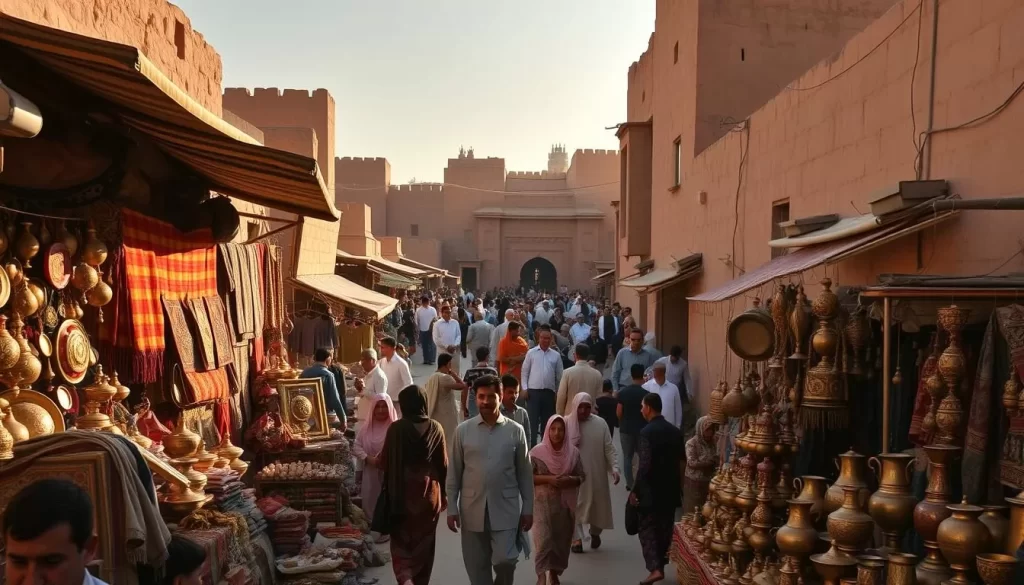
One of the most captivating aspects is the influence of the marsh on daily life. The wetlands have shaped not only the environment but also the culinary traditions. Dishes like masgouf, a grilled fish delicacy, and dolma, stuffed vegetables, are staples of the local food scene.
Artisan crafts are another highlight. From handmade carpets to intricate copper works, these creations reflect the skill and creativity of local artisans. Visiting workshops allows you to witness these traditions firsthand and even take home a piece of this rich culture.
Music and dance also play a significant role in local celebrations. Traditional performances, often accompanied by the oud and daf, bring communities together. These events are a vibrant expression of the region’s heritage and a must-see for any visitor.
“To truly understand a place, you must immerse yourself in its traditions. It’s through these experiences that you connect with the soul of the community.”
Here are some ways to engage with the local culture:
- Attend Festivals: Experience the energy of traditional celebrations.
- Visit Artisan Workshops: Learn about crafts like carpet weaving and pottery.
- Try Local Cuisine: Savor dishes that highlight the flavors of the marsh.
By embracing these experiences, you’ll gain a deeper appreciation for the region’s heritage. Whether it’s through food, crafts, or music, these traditions offer a truly authentic journey into the heart of the community.
Tips for Independent Travel in Iraq
Embarking on a solo journey in this region offers a unique blend of adventure and cultural immersion. With careful planning, you can navigate the challenges and enjoy a rewarding experience. Here’s how to make the most of your independent trip.
Navigating Local Transportation and Checkpoints
Getting around independently requires understanding local transportation options. Shared taxis and minibuses are affordable but may lack air conditioning. For more comfort, consider hiring a private cab, which costs around $50 per day.
Be prepared for security checkpoints, which are common throughout the region. Always carry identification and remain patient during inspections. This ensures a smooth journey and helps you stay safe.
Strategies for a Safe Solo Journey
Safety is a top priority when traveling alone. Dress modestly to respect local customs and avoid drawing unnecessary attention. This simple tip can make a big difference in how you’re perceived.
Stay connected with trusted locals or guides who can offer advice and assistance. Their insights into iraqi culture and daily life can enhance your experience and keep you informed.
Plan your itinerary carefully, especially when visiting remote areas. Ensure you have enough cash, as ATMs may not work with US banks. A daily budget of $45-$70 is recommended for independent travelers.
“Traveling solo here is about embracing the unexpected while staying prepared. It’s a journey that enriches your understanding of the world.”
Here are some additional tips to thrive as a solo traveler:
- Learn Basic Phrases: Knowing a few words in Arabic can help you navigate daily life more easily.
- Stay Informed: Keep up with local news and travel advisories to avoid risky areas.
- Pack Smart: Bring essentials like sunscreen, water, and a portable charger for your devices.
By following these strategies, you’ll be well-prepared for an independent adventure that highlights both the beauty and challenges of this region. Whether you’re exploring bustling cities or serene landscapes, these tips will help you make the most of your journey.
Best Photo Spots and Scenic Views in Ur and Beyond
Capture the essence of history through your lens as you explore breathtaking views and iconic landmarks. The location of the Great Ziggurat offers panoramic vistas, especially during golden hour. This ancient structure, with its towering presence, is a favorite among photographers.
For a unique perspective, head to the nearby desert landscapes. The interplay of light and shadow at sunrise or sunset creates a magical backdrop. These moments are perfect for capturing the timeless beauty of this historic location.
Timing is key to optimizing your photo opportunities. Early mornings and late afternoons provide the best lighting conditions. This information ensures you make the most of your photography sessions.
Don’t miss the hidden gems that locals cherish. These lesser-known spots offer a more intimate connection with the landscape. They are ideal for those seeking to document their journey beautifully.
Here are some practical tips for your photography adventure:
- Golden Hour: Plan your visits during sunrise or sunset for the best lighting.
- Vantage Points: Explore different angles to capture the full grandeur of the Ziggurat.
- Local Insights: Engage with locals to discover hidden photo spots.
For more travel inspiration, check out this guide to Erbil, an ancient city rich in history and culture. It’s a great way to expand your journey beyond this remarkable location.
Whether you’re a seasoned photographer or a casual traveler, these tips and information will help you capture the historic charm of this region. Enjoy your tea breaks at local cafes while reviewing your stunning shots.
Additional Tips for a Memorable Journey Through Ur
Make your journey unforgettable with these practical tips for exploring this ancient region. From budgeting to cultural exchanges, these insights will help you navigate your trip smoothly and enrich your experience at every level.
Start by planning your budget wisely. Local meals in eateries cost between 5,000 to 8,000 Iraqi Dinars (4 to 7 USD), while main courses in fancy restaurants start at 14,000 Iraqi Dinars (12 USD). This ensures you can enjoy the local cuisine without overspending.
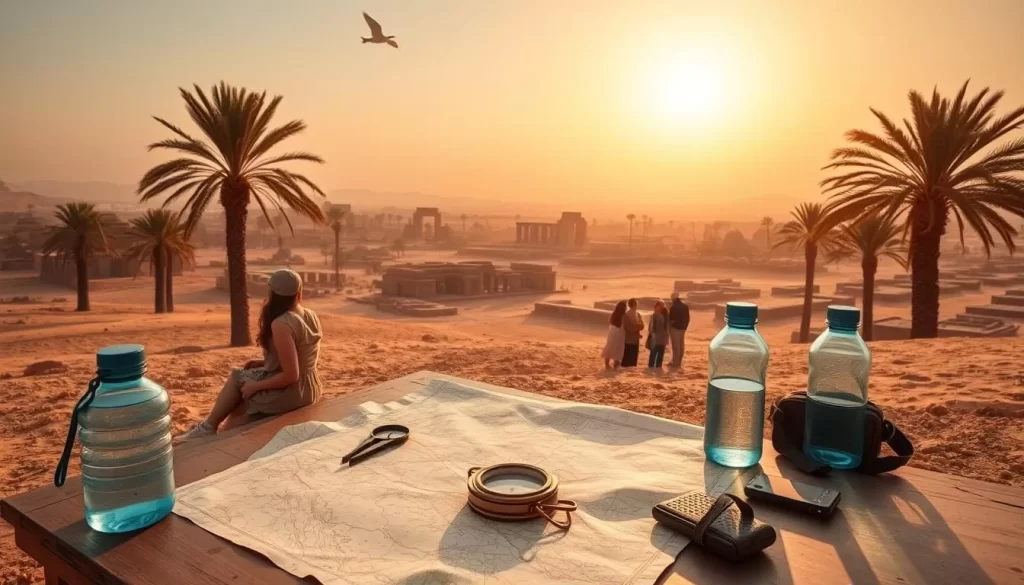
Prepare for the weather to stay comfortable during your trip. Summer temperatures can exceed 50°C (122°F), making conditions challenging for visitors. Pack lightweight, breathable clothing and stay hydrated to handle the heat.
Engaging with locals is a key part of your journey. A simple greeting like “a salaam alaikum” (peace be upon you) can open doors to meaningful cultural exchanges. This small effort helps you connect with the community and gain deeper insights into their way of life.
“Traveling is not just about seeing new places; it’s about understanding the people who call them home.”
To make the most of your visit, consider joining a guided tour. These tours often include transportation and expert insights, ensuring you don’t miss any highlights. They also provide a safe and structured way to explore the region.
Here are some additional tips to enhance your journey:
- Learn Basic Phrases: Knowing a few words in Arabic can ease daily interactions and enrich your cultural exchange.
- Respect Local Customs: Dress modestly and follow local etiquette to show respect for the culture.
- Stay Connected: Keep a local SIM card or portable Wi-Fi device to navigate and stay informed.
By following these tips, you’ll not only enjoy a hassle-free trip but also create lasting memories. Whether it’s through meaningful conversations or discovering hidden gems, every moment will feel like a step closer to understanding this remarkable home of history.
Conclusion
Exploring this region offers a unique blend of ancient history and modern-day adventures. From the towering architectural marvels to the vibrant local culture, every moment here feels like stepping into a living history book. Planning your trip carefully ensures you make the most of your journey, whether you’re marveling at ancient ruins or savoring traditional dishes.
For a seamless experience, consider hiring a taxi to navigate the area efficiently. This allows you to explore at your own pace while avoiding the challenges of limited public transport. Pair this with visits during the cooler months, and you’ll enjoy comfortable weather for sightseeing.
Safety is a priority, but with proper precautions, your trip can be both secure and enriching. Engaging with locals and respecting their customs fosters meaningful connections and deeper insights into the region’s heritage. For more tips on timing your visit, check out this guide on the best time to visit Iraqi Kurdistan.
This journey is more than just a trip—it’s an opportunity to connect with a land where history and culture intertwine. Whether you’re a history enthusiast or a curious traveler, the experiences here will leave a lasting impression.
The above is subject to change.
Check back often to TRAVEL.COM for the latest travel tips and deals.


